What'sNEW Archives, March-April 2006
 27 April 2006 27 April 2006
...Dawkins insists, and I agree wholeheartedly, that there aren't any good compromise positions. ...It cannot be done. And the recognition that it cannot be done is I would say, the mark of sane Darwinian fundamentalism. — Daniel C DennettDennett was one of six distinguished speakers at a celebration of the thirtieth anniversary of the publication of The Selfish Gene, by Richard Dawkins. His remarks there reconfirm that the subject of evolution is entirely polarized by the debate between darwinism and creationism/ID. This polarization is crippling to science.
 The Selfish Gene: Thirty Years On, reported on HuffPost; event held in London, 16 March 2006. The Selfish Gene: Thirty Years On, reported on HuffPost; event held in London, 16 March 2006.
 Evolution versus Creationism is a related CA webpage. Evolution versus Creationism is a related CA webpage.
 Thanks, Stan Franklin. Thanks, Stan Franklin.
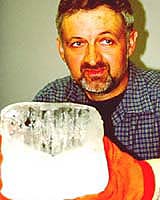
 24 April 2006 24 April 2006
Pristine samples of the Tagish Lake meteorite that fell in Alberta, Canada, six years ago, now belong to Canadian curation and research facilities. "The University of Alberta, through the Department of Museums and Collections Services and the Department of Earth and Atmospheric Sciences, led a consortium of partners that, together, acquired the pristine samples for mutual research and heritage interests. These partners include the Department of Canadian Heritage, the Royal Ontario Museum, Natural Resources Canada, and the Canadian Space Agency." Other samples that underwent the spring thaw were found to contain "unfamiliar organic globules." The newly acquired samples, however, were gathered while still frozen by local resident Jim Brook (right). It will be interesting to learn what they contain (and how much they cost!)
 One-Of-A-Kind Meteorite Unveiled, SpaceDaily.com, 24 Apr 2006. One-Of-A-Kind Meteorite Unveiled, SpaceDaily.com, 24 Apr 2006.
 Comets: The Delivery System is the related CA webpage. Search for "Tagish." Comets: The Delivery System is the related CA webpage. Search for "Tagish."
 Thanks, Jim Galasyn. Thanks, Jim Galasyn.
 15 April 2006 15 April 2006
The Evolution Prize will be launched hopefully at ALife X, the 10th International Conference on the Simulation and Synthesis of Living Systems, in Bloomington, Indiana, 3-7 June 2006. The prize will honor the person or team who can demonstrate open-ended evolutionary innovation in a closed system. A workshop session cochaired by Mark Bedau and Brig Klyce will consider how to establish and administer the prize, sponsored by the Astrobiology Research Trust. A new CA webpage has details and links —

 "The Evolution Prize: Is Open-Ended Evolutionary Innovation in a Closed System Possible?" [doc | pdf] — the conference abstract. "The Evolution Prize: Is Open-Ended Evolutionary Innovation in a Closed System Possible?" [doc | pdf] — the conference abstract.
 The Evolution Prize... is the new CA webpage. The Evolution Prize... is the new CA webpage.
 ...Is Evolutionary Progress in a Closed System Possible? is a related CA webpage. ...Is Evolutionary Progress in a Closed System Possible? is a related CA webpage.
 Is Sustained Macroevolutionary Progress Possible? is a related CA webpage. Is Sustained Macroevolutionary Progress Possible? is a related CA webpage.
 Testing Darwinism versus Cosmic Ancestry is a related CA webpage. Testing Darwinism versus Cosmic Ancestry is a related CA webpage.
 Can The Theory Be Tested? is a related CA webpage. Can The Theory Be Tested? is a related CA webpage.
 ALife X, Bloomington, Indiana, 3-7 June 2006. ALife X, Bloomington, Indiana, 3-7 June 2006.
 The Astrobiology Research Trust, sponsor of the prize. The Astrobiology Research Trust, sponsor of the prize.
 14 April 2006 14 April 2006
Astrobiology legitimately broadens the terms of exobiology to include the study of life on Earth, which in this context is just another planet....
 "Astrobiology at ten: A young discipline holds promise yet" [html], doi:10.1038/440582a, p 582 v 440, Nature, 30 Mar 2006. "Astrobiology at ten: A young discipline holds promise yet" [html], doi:10.1038/440582a, p 582 v 440, Nature, 30 Mar 2006.
 Introduction... is a related CA webpage. Introduction... is a related CA webpage.
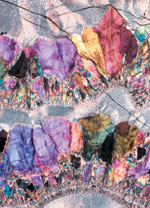
Dresser Formation quartz (width = c. 3 mm) |
 9 April 2006 9 April 2006
Microbes produced methane on Earth 3.5 billion years ago, according to Japanese environmental scientists. They found the methane in tiny fluid inclusions in quartz from Australia's Dresser Formation, whose age is known. Carbon isotope ratios indicate that the methane was probably produced biologically. If so, methanogens were active on Earth 700 million years earlier than previously thought. Intriguingly, the microbes may have lived as much as a kilometer deep underground. Methane is an effective greenhouse gas that would have helped to warm the planet when the sun was dimmer. Methane is also present in the atmospheres of other planets, and moons like Saturn's Titan. We wonder if those planets and moons could be at developmental stages through which Earth passed earlier.
 Yuichiro Ueno et al., "Evidence from fluid inclusions for microbial methanogenesis in the early Archaean era" [text], 10.1038/nature04584, p 516-519 v 440, Nature, 23 Mar 2006. Yuichiro Ueno et al., "Evidence from fluid inclusions for microbial methanogenesis in the early Archaean era" [text], 10.1038/nature04584, p 516-519 v 440, Nature, 23 Mar 2006.
 Don E. Canfield, "Gas with an ancient history" [text], p 426-427 v 440, Nature, 23 Mar 2006. Don E. Canfield, "Gas with an ancient history" [text], p 426-427 v 440, Nature, 23 Mar 2006.
 Gaia is a CA webpage about how biology can alter the environment. Gaia is a CA webpage about how biology can alter the environment.
 Life on Europa or Other Moons? has links to articles about moons like Titan. Life on Europa or Other Moons? has links to articles about moons like Titan.
 8 April 2006 8 April 2006
Irreducible complexity solved! — the latest news from mainstream darwinists. Even The Wall Street Journal has heard about it. This time the featured problem is the lock-and-key relationship between the steroid hormone aldosterone and its enzyme receptor. How could they have evolved separately to match so perfectly? Three evolutionary biologists at the University of Oregon looked into it, reporting in yesterday's Science:
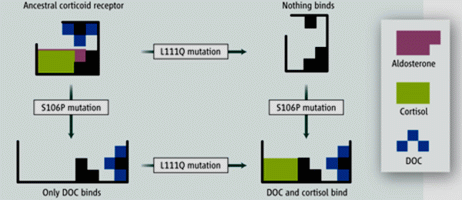 "Using ancestral gene resurrection, we show that, long before the hormone evolved, the receptor's affinity for aldosterone was present as a structural by-product of its partnership with chemically similar, more ancient ligands. Introducing two amino acid changes into the ancestral sequence recapitulates the evolution of present-day receptor specificity. Our results indicate that tight interactions can evolve by molecular exploitation—recruitment of an older molecule, previously constrained for a different role, into a new functional complex." Taking the hype to a new level, Christoph Adami of the Keck Graduate Institute of Applied Life Sciences writes, "Whatever debate remains must be characterized as purely political."
"Using ancestral gene resurrection, we show that, long before the hormone evolved, the receptor's affinity for aldosterone was present as a structural by-product of its partnership with chemically similar, more ancient ligands. Introducing two amino acid changes into the ancestral sequence recapitulates the evolution of present-day receptor specificity. Our results indicate that tight interactions can evolve by molecular exploitation—recruitment of an older molecule, previously constrained for a different role, into a new functional complex." Taking the hype to a new level, Christoph Adami of the Keck Graduate Institute of Applied Life Sciences writes, "Whatever debate remains must be characterized as purely political."
If an ancient protein could also do a modern job with only slight tweaking, that's the remarkable fact here. How does darwinism account for that capability? As our regular readers know, the phenomenon we question is even simpler than irreducible complexity. We want to know if sustainable evolutionary progress is possible in a genetically closed system. To reconstruct evolutionary events millions of years ago from today's genomes, darwinists begin by assuming the answer is yes. Therefore, one or a few isolated historical reconstructions can hardly answer our question. Demonstrations can.
 Jamie T. Bridgham, Sean M. Carroll and Joseph W. Thornton, "Evolution of Hormone-Receptor Complexity by Molecular Exploitation" [abstract] 10.1126/science.1123348, p 97-101 v 312, Science, 7 Apr 2006. Jamie T. Bridgham, Sean M. Carroll and Joseph W. Thornton, "Evolution of Hormone-Receptor Complexity by Molecular Exploitation" [abstract] 10.1126/science.1123348, p 97-101 v 312, Science, 7 Apr 2006.
 Christoph Adami, "Reducible Complexity" [summary] 10.1126/science.1126559, p 61-63 v 312, Science, 7 Apr 2006. Christoph Adami, "Reducible Complexity" [summary] 10.1126/science.1126559, p 61-63 v 312, Science, 7 Apr 2006.
 Sharon Begley, "Two New Discoveries Answer Big Questions in Evolution Theory" [link], p B1, The Wall Street Journal, 7 Apr 2006. Sharon Begley, "Two New Discoveries Answer Big Questions in Evolution Theory" [link], p B1, The Wall Street Journal, 7 Apr 2006.
 Evolution Of Irreducible Complexity Explained, TerraDaily.com, 7 Apr 2006. "The evolution of complex molecular systems... has been an unsolved issue in evolutionary biology." Evolution Of Irreducible Complexity Explained, TerraDaily.com, 7 Apr 2006. "The evolution of complex molecular systems... has been an unsolved issue in evolutionary biology."
 Evolution versus Creationism is a related CA webpage. Evolution versus Creationism is a related CA webpage.
 Thanks, Larry Klaes. Thanks, Larry Klaes.
 6 April 2006 6 April 2006
The Genomic Impact of Eukaryotic Transposable Elements was the theme of a science conference over the weekend in Pacific Grove, California. The most impressive news to us was that genomic evolution is going on right now among higher life forms, including humans. The accumulation of genome sequence data makes it possible to recognize this phenomenon. Interspersed mobile genetic elements of various kinds constitute more of our genomes than genes do, and most of them have become inactive. A small percentage, however, are "hot," moving about within our genomes from one generation to the next. Their effects are usually unknown, but sometimes, deleterious.
 Jerzy Jurka of The Genetic Information Research Institute opened the conference with a brief history of the study of eukaryotic transposable elements. He concluded by asking if life could have evolved to its current level of complexity without the activity of those elements. He answered, "I don't think so." After hearing most of the 48 scheduled presentations, perusing sixty or more posters, and visiting with several of the 150+ researchers from around the world, we don't think so either. And we were specially pleased to meet and talk with Margaret Kidwell, Regents' Professor, Ecology and Evolutionary Biology at the University of Arizona.
Jerzy Jurka of The Genetic Information Research Institute opened the conference with a brief history of the study of eukaryotic transposable elements. He concluded by asking if life could have evolved to its current level of complexity without the activity of those elements. He answered, "I don't think so." After hearing most of the 48 scheduled presentations, perusing sixty or more posters, and visiting with several of the 150+ researchers from around the world, we don't think so either. And we were specially pleased to meet and talk with Margaret Kidwell, Regents' Professor, Ecology and Evolutionary Biology at the University of Arizona.
 The Genomic Impact of Eukaryotic Transposable Elements, The Asilomar Conference Center, Pacific Grove, CA, USA, 31 Mar - 4 Apr 2006. The Genomic Impact of Eukaryotic Transposable Elements, The Asilomar Conference Center, Pacific Grove, CA, USA, 31 Mar - 4 Apr 2006.
 "The Genomic Impact of Eukaryotic Transposable Elements" will be featured in a special issue of Gene. "The Genomic Impact of Eukaryotic Transposable Elements" will be featured in a special issue of Gene.
 Maria del Carmen Seleme et al., "Extensive individual variation in L1 retrotransposition capability contributes to human genetic diversity" [abstract], 10.1073/pnas.0601324103, Proc. Natl. Acad. Sci. USA, online 17 Apr 2006. Maria del Carmen Seleme et al., "Extensive individual variation in L1 retrotransposition capability contributes to human genetic diversity" [abstract], 10.1073/pnas.0601324103, Proc. Natl. Acad. Sci. USA, online 17 Apr 2006.
 Viruses and Other Gene Transfer Mechanisms is the main related CA webpage [ Viruses and Other Gene Transfer Mechanisms is the main related CA webpage [ What'sNEW about HGT What'sNEW about HGT  ]. ].
 Thanks, Tom Ray, for alerting us to the conference. Thanks, Tom Ray, for alerting us to the conference.
 24 March 2006 24 March 2006
Viruses And The Evolution Of Life, by Luis P. Villarreal, expands on the points he made in a paper given at the American Philosophical Society, 15 Nov 2003, "Can Viruses Make Us Human?" He concludes, "We can no longer deny [viruses'] important role in the evolution of life. ...They can ...add new layers of complexity and genetic identity to their hosts in episodic events through persistence and genomic colonization. This process would appear to be cumulative, resulting in ever-greater host complexity" (p 373).
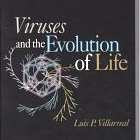 For a specific example, with respect to adaptive immunity he writes, "...The molecular machinery needed to generate the adaptive component of vertebrate immunity can be found in various persistent viral, not cellular, genomes. ...No one virus family has all the needed functions. ...The extensive complexity of the adaptive immune system suggests that a specific or single viral agent would be unlikely to be able to provide all the required gene functions. This point, along with the high-level ERV colonization that now characterizes all vertebrate genomes, suggests that the acquisition of adaptive immunity was a complex and punctuated event" (p 211-212).
For a specific example, with respect to adaptive immunity he writes, "...The molecular machinery needed to generate the adaptive component of vertebrate immunity can be found in various persistent viral, not cellular, genomes. ...No one virus family has all the needed functions. ...The extensive complexity of the adaptive immune system suggests that a specific or single viral agent would be unlikely to be able to provide all the required gene functions. This point, along with the high-level ERV colonization that now characterizes all vertebrate genomes, suggests that the acquisition of adaptive immunity was a complex and punctuated event" (p 211-212).
 Luis P. Villarreal, Viruses And The Evolution Of Life, ASM Press, Jan 2005. Luis P. Villarreal, Viruses And The Evolution Of Life, ASM Press, Jan 2005.
 2000 2000
 2006 2006
 2014 2014
 2015: more from Villarreal. 2015: more from Villarreal.
 Viruses and Other Gene Transfer Mechanisms is the main related CA webpage [ Viruses and Other Gene Transfer Mechanisms is the main related CA webpage [ What'sNEW about HGT What'sNEW about HGT  ]. ].
 20 March 2006 20 March 2006
Advantageous genes, probably introduced by retroviruses, are known in bacteria and in humans — Barry Blumberg
 Baruch S. Blumberg, "Hepatitis B Virus. Conjectures on Human Interactions and the Origin of Life," in Life As We Know It, v 10 of the series Cellular Origin, Life in Extreme Habitats and Astrobiology, J. Seckbach, editor, Springer, Dordrecht, NL, due May 2006. Baruch S. Blumberg, "Hepatitis B Virus. Conjectures on Human Interactions and the Origin of Life," in Life As We Know It, v 10 of the series Cellular Origin, Life in Extreme Habitats and Astrobiology, J. Seckbach, editor, Springer, Dordrecht, NL, due May 2006.
 Viruses and Other Gene Transfer Mechanisms is the main related CA webpage [ Viruses and Other Gene Transfer Mechanisms is the main related CA webpage [ What'sNEW about HGT What'sNEW about HGT  ]. ].
 18 March 2006 18 March 2006
Earthly bacteria could have reached distant planets and moons, according to astrobiologists in Canada and the US. Their study was presented at a conference this week in Houston.
 B. Gladman et al., "Meteoroid transfer to Europa and Titan" [2165.pdf], Lunar and Planetary Science XXXVII, 13-17 Mar 2006. B. Gladman et al., "Meteoroid transfer to Europa and Titan" [2165.pdf], Lunar and Planetary Science XXXVII, 13-17 Mar 2006.
 Did Earth seed life elsewhere in the Solar System?, by Mark Peplow, News@Nature.com, 17 Mar 2006. Did Earth seed life elsewhere in the Solar System?, by Mark Peplow, News@Nature.com, 17 Mar 2006.
 Thanks, Larry Klaes and Stuart Udall. Thanks, Larry Klaes and Stuart Udall.
 15 March 2006 15 March 2006
The paradigm for evolution among prokaryotes has completely shifted. This shift was already becoming clear more than three years ago, according to a scholarly review article by three distinguished North American biologists. They began, "Accumulating prokaryotic gene and genome sequences reveal that the exchange of genetic information through both homology-dependent recombination and horizontal (lateral) gene transfer (HGT) is far more important, in quantity and quality, than hitherto imagined." Their supporting points include –

Gene transfer can create patterns of similarity and difference that mimic patterns produced by vertical descent. If taxa A and B successfully exchange genetic information (by homologous recombination or HGT) more frequently with each other than with taxon C, they will come to resemble each other more closely than they do C, both in gene content and gene sequence. Treelike patterns based on gene content or sequence will reflect these different frequencies, not some underlying organismal phylogeny. |
- HGT can fundamentally alter the character of a microbial species by introducing fully functional genes and gene clusters that can confer complex phenotypes and functions.
- In contrast, variation introduced by point mutation will, most of the time, only adjust preexisting phenotypes.
- While fitness peaks may never be explored if they must be reached one gene at a time, multiple genes may be acquired in the form of bacterial operons and gene clusters.
- No gene appears immune to HGT. Genes encoding core metabolic functions..., conserved biosynthetic pathways..., components of the transcription and translation machinery..., and even ribosomal RNA... have been subject to HGT.
- Ironically, ...preferential gene exchange could create many of the very same patterns of similarity and difference we usually attribute to vertical inheritance [see figure and legend at right].
- Only a small subset of HGTs can be detected with confidence; the majority of transfers, especially those that occurred long ago or between closely related species, will likely escape detection.
- The mismatch repair genes themselves show a complex history of recombination attributed to loss and recovery (through horizontal transfer)....
- Embracing gene transfer promises a broad and radical revision of the prokaryotic evolutionary paradigm.
- HGT can occur between even very distantly related organisms, e.g., between bacteria and plants or fungi....
- Of course natural selection will act as the arbiter of success for all recombinant cells.
Today, we think the paradigm shift for evolution among prokaryotes needs more attention than it gets, because it challenges the strictly darwinian account of the source of new genetic programs. (What remaining evidence among prokaryotes supports that acccount?) Among eukaryotes also, the growing evidence for gene transfer is now shifting the evolutionary paradigm, and this shift also gets scant attention. Why?
 J. Peter Gogarten, W. Ford Doolittle, and Jeffrey G. Lawrence, "Prokaryotic Evolution in Light of Gene Transfer" [abstract | full text], p 2226-2238, v 19, Molecular Biology and Evolution, Dec 2002. J. Peter Gogarten, W. Ford Doolittle, and Jeffrey G. Lawrence, "Prokaryotic Evolution in Light of Gene Transfer" [abstract | full text], p 2226-2238, v 19, Molecular Biology and Evolution, Dec 2002.
 Viruses and Other Gene Transfer Mechanisms is the main related CA webpage [ Viruses and Other Gene Transfer Mechanisms is the main related CA webpage [ What'sNEW about HGT What'sNEW about HGT  ]. ].
 The Tree of Life is a related CA webpage. The Tree of Life is a related CA webpage.
 03 Mar 2021: To model bacterial evolution, HGT alone works best. 03 Mar 2021: To model bacterial evolution, HGT alone works best.
 13 March 2006 13 March 2006
Fire and ice — That's how Don Brownlee, lead scientist for NASA's Stardust mission, describes the first examined particles returned from comet Wild 2. The comet was thought to have formed and resided in cold deep space beyond Neptune until 1974, when its orbit was bent closer to the sun by an encounter with Jupiter. But the Stardust samples contain lots of olivine, which is believed to form under much higher temperatures. Other high-temperature minerals rich in calcium, aluminum and titanium reinforce the view that the particles were formed under heat. "I would say these materials came from the inner, warmest parts of the solar system or from hot regions around other stars," Brownlee said. Planned isotope testing may point to one source or the other.
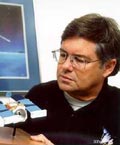
Don Brownlee |
 Stardust Samples Show Evidence of Fire, Ice, Stardust Homepage at NASA, 13 Mar 2006. Stardust Samples Show Evidence of Fire, Ice, Stardust Homepage at NASA, 13 Mar 2006.
 Comet from coldest spot in solar system has material from hottest places, University of Washington, 13 Mar 2006. Comet from coldest spot in solar system has material from hottest places, University of Washington, 13 Mar 2006.
 A Hot Origin for Icy Comets, by Richard A. Kerr, ScienceNOW Daily News, 14 Mar 2006. A Hot Origin for Icy Comets, by Richard A. Kerr, ScienceNOW Daily News, 14 Mar 2006.
 Comets: The Delivery System is a related CA webpage. Comets: The Delivery System is a related CA webpage.
 ...Interstellar Dust is a related CA webpage. ...Interstellar Dust is a related CA webpage.
 Comet Rendezvous, a section of the webpage, "Can the Theory Be Tested?" has more about the Stardust mission. Comet Rendezvous, a section of the webpage, "Can the Theory Be Tested?" has more about the Stardust mission.
 Thanks Jim Galasyn and EurekAlert!. Thanks Jim Galasyn and EurekAlert!.
 13 March 2006 13 March 2006
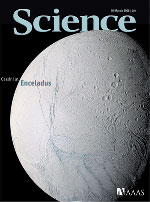 Wet Enceladus is featured in a special issue of Science. The sixth largest moon of Saturn, 504 km in diameter, Enceladus was the object of three passes by the Cassini spacecraft that has been orbiting Saturn since 1 July 2004. In commentary Joanne Baker writes, "The flybys show that Enceladus' south polar landscape is still active today and is being resurfaced by cryovolcanism and fresh snowfall. Tidal forces have twisted and buckled the surface ice, producing long ridges and fractures. At infrared wavelengths, the south pole actually glows. An underground heat source lies beneath a surface grid of "tiger stripes": a parallel set of linear trenches stained with dark organic material. From these warm vents, water vapor, ice, and dust particles are lofted in a spectacular plume, like spray from a Yellowstone geyser. Ions are driven further into the atmosphere and out into the magnetosphere of Saturn itself and the E ring. The rate at which water is being blown out is enough to replenish not only the E ring but also oxygen throughout the whole saturnian system."
Wet Enceladus is featured in a special issue of Science. The sixth largest moon of Saturn, 504 km in diameter, Enceladus was the object of three passes by the Cassini spacecraft that has been orbiting Saturn since 1 July 2004. In commentary Joanne Baker writes, "The flybys show that Enceladus' south polar landscape is still active today and is being resurfaced by cryovolcanism and fresh snowfall. Tidal forces have twisted and buckled the surface ice, producing long ridges and fractures. At infrared wavelengths, the south pole actually glows. An underground heat source lies beneath a surface grid of "tiger stripes": a parallel set of linear trenches stained with dark organic material. From these warm vents, water vapor, ice, and dust particles are lofted in a spectacular plume, like spray from a Yellowstone geyser. Ions are driven further into the atmosphere and out into the magnetosphere of Saturn itself and the E ring. The rate at which water is being blown out is enough to replenish not only the E ring but also oxygen throughout the whole saturnian system."
 Cassini at Enceladus, p 1388-1428 v 311, Science, 10 Mar 2006. Cassini at Enceladus, p 1388-1428 v 311, Science, 10 Mar 2006.
 Cassini measures geysers of Saturn's moon Enceladus, Los Alamos National Laboratory, 10 Mar 2006. Cassini measures geysers of Saturn's moon Enceladus, Los Alamos National Laboratory, 10 Mar 2006.
 Radical! Liquid Water on Enceladus, Science@NASA, 9 Mar 2006. Radical! Liquid Water on Enceladus, Science@NASA, 9 Mar 2006.
 Saturn Moon Has Water Geysers and, Just Maybe, Life, by Elizabeth Svoboda, National Geographic News, 10 Mar 2006. Saturn Moon Has Water Geysers and, Just Maybe, Life, by Elizabeth Svoboda, National Geographic News, 10 Mar 2006.
 Enceladus and the Search for Water, Astronomy Picture of the Day, 10 Mar 2006. Enceladus and the Search for Water, Astronomy Picture of the Day, 10 Mar 2006.
 Ice Volcanoes on Saturn's Moon Enceladus, Max Planck Institute for Nuclear Physics, 14 Mar 2006. Ice Volcanoes on Saturn's Moon Enceladus, Max Planck Institute for Nuclear Physics, 14 Mar 2006.
 Life on Europa or Other Moons? is a CA webpage with related links. Life on Europa or Other Moons? is a CA webpage with related links.
 Thanks, Katy and Doug Martin, and Kevin Keogh. Thanks, Katy and Doug Martin, and Kevin Keogh.
 2 March 2006 2 March 2006
Endogenous proviruses are widespread in nature, and have been found in all vertebrate and most invertebrate species that have been studied, indicative of the barrage of retroviruses to which all species have been subjected throughout their evolutionary history. In humans, there are about 80,000 proviruses or their remnants, comprising about 6-8% of the genome, or about twice as many as genes. In other words, there are more proviruses in us than there is us in us.
 John M. Coffin, "Evolution of Retroviruses: Fossils in our DNA," p 264-280 v 148 n 3, Proceedings of the American Philosophical Society, Sep 2004. John M. Coffin, "Evolution of Retroviruses: Fossils in our DNA," p 264-280 v 148 n 3, Proceedings of the American Philosophical Society, Sep 2004.
 Viruses and Other Gene Transfer Mechanisms is the main related CA webpage [ Viruses and Other Gene Transfer Mechanisms is the main related CA webpage [ What'sNEW about HGT What'sNEW about HGT  ]. ].
|
 Wet Enceladus is featured in a special issue of Science. The sixth largest moon of Saturn, 504 km in diameter, Enceladus was the object of three passes by the Cassini spacecraft that has been orbiting Saturn since 1 July 2004. In commentary Joanne Baker writes, "The flybys show that Enceladus' south polar landscape is still active today and is being resurfaced by cryovolcanism and fresh snowfall. Tidal forces have twisted and buckled the surface ice, producing long ridges and fractures. At infrared wavelengths, the south pole actually glows. An underground heat source lies beneath a surface grid of "tiger stripes": a parallel set of linear trenches stained with dark organic material. From these warm vents, water vapor, ice, and dust particles are lofted in a spectacular plume, like spray from a Yellowstone geyser. Ions are driven further into the atmosphere and out into the magnetosphere of Saturn itself and the E ring. The rate at which water is being blown out is enough to replenish not only the E ring but also oxygen throughout the whole saturnian system."
Wet Enceladus is featured in a special issue of Science. The sixth largest moon of Saturn, 504 km in diameter, Enceladus was the object of three passes by the Cassini spacecraft that has been orbiting Saturn since 1 July 2004. In commentary Joanne Baker writes, "The flybys show that Enceladus' south polar landscape is still active today and is being resurfaced by cryovolcanism and fresh snowfall. Tidal forces have twisted and buckled the surface ice, producing long ridges and fractures. At infrared wavelengths, the south pole actually glows. An underground heat source lies beneath a surface grid of "tiger stripes": a parallel set of linear trenches stained with dark organic material. From these warm vents, water vapor, ice, and dust particles are lofted in a spectacular plume, like spray from a Yellowstone geyser. Ions are driven further into the atmosphere and out into the magnetosphere of Saturn itself and the E ring. The rate at which water is being blown out is enough to replenish not only the E ring but also oxygen throughout the whole saturnian system."


 "Using ancestral gene resurrection, we show that, long before the hormone evolved, the receptor's affinity for aldosterone was present as a structural by-product of its partnership with chemically similar, more ancient ligands. Introducing two amino acid changes into the ancestral sequence recapitulates the evolution of present-day receptor specificity. Our results indicate that tight interactions can evolve by molecular exploitation—recruitment of an older molecule, previously constrained for a different role, into a new functional complex." Taking the hype to a new level, Christoph Adami of the Keck Graduate Institute of Applied Life Sciences writes, "Whatever debate remains must be characterized as purely political."
"Using ancestral gene resurrection, we show that, long before the hormone evolved, the receptor's affinity for aldosterone was present as a structural by-product of its partnership with chemically similar, more ancient ligands. Introducing two amino acid changes into the ancestral sequence recapitulates the evolution of present-day receptor specificity. Our results indicate that tight interactions can evolve by molecular exploitation—recruitment of an older molecule, previously constrained for a different role, into a new functional complex." Taking the hype to a new level, Christoph Adami of the Keck Graduate Institute of Applied Life Sciences writes, "Whatever debate remains must be characterized as purely political." Jerzy Jurka of The Genetic Information Research Institute opened the conference with a brief history of the study of eukaryotic transposable elements. He concluded by asking if life could have evolved to its current level of complexity without the activity of those elements. He answered, "I don't think so." After hearing most of the 48 scheduled presentations, perusing sixty or more posters, and visiting with several of the 150+ researchers from around the world, we don't think so either. And we were specially pleased to meet and talk with Margaret Kidwell, Regents' Professor, Ecology and Evolutionary Biology at the University of Arizona.
Jerzy Jurka of The Genetic Information Research Institute opened the conference with a brief history of the study of eukaryotic transposable elements. He concluded by asking if life could have evolved to its current level of complexity without the activity of those elements. He answered, "I don't think so." After hearing most of the 48 scheduled presentations, perusing sixty or more posters, and visiting with several of the 150+ researchers from around the world, we don't think so either. And we were specially pleased to meet and talk with Margaret Kidwell, Regents' Professor, Ecology and Evolutionary Biology at the University of Arizona. For a specific example, with respect to adaptive immunity he writes, "...The molecular machinery needed to generate the adaptive component of vertebrate immunity can be found in various persistent viral, not cellular, genomes. ...No one virus family has all the needed functions. ...The extensive complexity of the adaptive immune system suggests that a specific or single viral agent would be unlikely to be able to provide all the required gene functions. This point, along with the high-level ERV colonization that now characterizes all vertebrate genomes, suggests that the acquisition of adaptive immunity was a complex and punctuated event" (p 211-212).
For a specific example, with respect to adaptive immunity he writes, "...The molecular machinery needed to generate the adaptive component of vertebrate immunity can be found in various persistent viral, not cellular, genomes. ...No one virus family has all the needed functions. ...The extensive complexity of the adaptive immune system suggests that a specific or single viral agent would be unlikely to be able to provide all the required gene functions. This point, along with the high-level ERV colonization that now characterizes all vertebrate genomes, suggests that the acquisition of adaptive immunity was a complex and punctuated event" (p 211-212).
